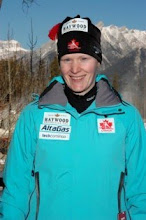Biathlon is a combination of skiing and shooting. During a race, you ski a loop and then come into the biathlon shooting range where the targets are set up, shoot, then ski another loop. Depending on the race distance, for Paralympic skiers, we’ll do between three to five laps with two to four trips through the range. Each time you shoot, you have to hit five targets. For each miss, depending on the race, you either have to ski a penalty loop or a time penalty is added to your official time.
Considering I can’t see trail signs, let alone small biathlon targets, how is it that I am entered in two biathlon races for the World Cup? Instead of shooting at visible targets, visually impaired skiers shoot with Eko rifles that use invisible laser beams (I know, it sounds a little Star Trekkish!) instead of bullets. In the biathlon range, we have five targets that look similar to those used by sighted athletes except that when the laser beam makes contact with each target and assuming we pull the trigger while it’s focused there, the target lights up green. If we miss, it turns red. Instead of visually lining up our guns with the targets, the Eko rifles come with headphones through which I hear how close I am to hitting the target. The higher the pitch, the closer I am. With practice, I’ve finally developed an ear for the exact pitch that indicates I’m right on target.
Shooting well requires that you are calm and preferably not breathing hard as even breathing in and out changes the angle of where the gun is pointed. So the trick in biathlon is to ski the loops hard, but yet come into the range relaxed enough to shoot well. My background in track and field has really been valuable in this regard because it too required me to develop the ability to stay relaxed under stressful conditions, to concentrate on the here and now and to ignore potential distractions. Whether it was long jumping, throwing the discus or running the 800m, I had to be focused on what I was doing and ignore what was going on around me. Biathlon is no different.
Here at the World Cup races, Andrea and I are only doing the short (7.5km with two shooting rounds) and pursuit (1.5km plus two shooting rounds) biathlons. All biathlon races are free technique, or skating. My strength is classic so the biathlon races will both be a good challenge for me, but it gives us extra practice skiing in traffic. Unlike able-bodied races, here everyone here who is visually impaired skis with a guide, effectively doubling the number of bodies out on the course. It can make for some entertaining race tactics!
Actually, there is a funny story to that effect! In 2007, Lisa and I were racing in a 15km classic World Cup event at Mount Washington. On one section of the course, there was a long downhill with two sets of classic tracks going down the middle. The downhill was fairly long and turned left at the bottom just enough so that you couldn’t see what was around the corner. Lisa and I pushed hard over the top of the hill and tucked in the tracks while going down. We really started to pick up speed and I started gaining on her. I stepped out of the tracks so I was between the two sets of tracks with Lisa on my right still in the tracks. As we came around the corner, there was a skier in the left set of tracks, but we were moving so fast, we couldn’t do anything but keep going where we were. I barely made it between Lisa and the other skier! It wasn’t until after the race that Lisa informed me that other skier was an amputee who had no right arm. “If she’s had an arm and a pole, you would have taken her out for sure!” Lisa laughed after the race.



No comments:
Post a Comment